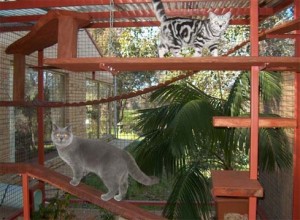 Many of us keep our cats indoors these days – for their health and to protect the lizards and birds in our streets.
Many of us keep our cats indoors these days – for their health and to protect the lizards and birds in our streets.
Today Dr Helen found lots of ideas for cat enclosures. Surely my cats will approve of one of them!
 Many of us keep our cats indoors these days – for their health and to protect the lizards and birds in our streets.
Many of us keep our cats indoors these days – for their health and to protect the lizards and birds in our streets.
Today Dr Helen found lots of ideas for cat enclosures. Surely my cats will approve of one of them!
Dementia, also known as feline cognitive dysfunction, is an age-related disorder of brain function causing multiple behaviour changes.
In cats the behaviour changes include:
 Some diseases mimic cognitive dysfunction. These include hyperthyroidism, brain tumours, viral diseases, high blood pressure, chronic pain, arthritis, diabetes, and urinary tract infections. Many of these diseases exacerbate the behaviour changes of cognitive dysfunction, too, so we must check for and/or treat them before we confirm a diagnosis of cognitive dysfunction.
Some diseases mimic cognitive dysfunction. These include hyperthyroidism, brain tumours, viral diseases, high blood pressure, chronic pain, arthritis, diabetes, and urinary tract infections. Many of these diseases exacerbate the behaviour changes of cognitive dysfunction, too, so we must check for and/or treat them before we confirm a diagnosis of cognitive dysfunction.
Some commonly used drugs such as prednisolone and valium also reduce brain function. Alternatives that reduce decline are often available.
Therapies
1. Diet: Anti-oxidants delay and treat dementia. Antioxidants include Vitamin E, Vitamin C, Alpha-lipoic acid, L-carnitine and beta-carotene. Fruits and vegetables contain many of these.
Omega 3 fatty acids as found in fish oil or food supplements such as Nutricoat also help.
2. Physical therapy and environmental enrichment: Stimulate brain function and delay the onset of dementia with environmental enrichment and games. Try scattering or hiding food or catnip around the house, provide toys that require batting or rolling to release food, give opportunities for climbing, perching and exploring, trail ribbon or feathers along. Petting, brushing and massage stimulate the nerves and brains of old cats, too.
3. Your vet may prescribe medications to reduce inflammation, enhance memory or improve brain function.
Dogs suffer from heart failure, just like humans. If dog owners recognise the warning signs of heart failure they can seek help earlier and enjoy a healthy, happy pet for longer.
 Research shows that most dog owners are not aware of the risk of heart failure in older dogs, even though 1 in 10 dogs presented to vets suffer from heart disease.
Research shows that most dog owners are not aware of the risk of heart failure in older dogs, even though 1 in 10 dogs presented to vets suffer from heart disease.
Boehringer Ingelheim has launched a Heart Failure Awareness Program to raise owners’ awareness of the signs of heart disease in dogs. The company wants to reduce the numbers of dogs suffering unnecessarily from this life threatening condition.
The Heart Failure Awareness Program is aimed at dog owners because they are most likely to notice changes in their dog’s health and behaviour.
Early signs of heart failure, like loss of appetite, are subtle and often overlooked.
The common signs of congestive heart failure include:
If your dog is aged seven or more and showing one or more of the above signs visit a vet without delay.
Effective treatment of heart failure is available and when started early greatly improves affected dogs’ quality of life.
If owners recognise the signs of heart failure early and seek veterinary advice before the heart deteriorates markedly, treatment has the greatest benefit.
Research has shown effective treatment allows dogs with heart failure to enjoy many healthy, good quality years of life.
And that’s something all dog owners want.
Nurse Tegan helped Mischief out of his winter coat and into his summer splendour this morning. Over winter he can’t keep up with his long hair and it was matted on his sides and belly and up behind his ears.
Mischief is usually pretty laid back and purry but he asked for a sedative so we could clean up those matts behind his ears without hurting him.
He says it takes him a few days to get used to losing his winter coat each year but he soon appreciates the lighter easier style.
Tapeworms and roundworms are the most common intestinal parasites of cats.
Tapeworms are long flat worms composed of many individual segments which look like wriggling grains of rice in cat faeces.
Round worms are much shorter and rounder and produce microscopic eggs. Hookworm and whipworm are rarer but cause anæmia, loss of protein and gastrointestinal upsets.
Cats are infested with the flea tapeworm Dipylidium caninum by eating fleas carrying the tapeworm during grooming. The tapeworm mature in cats and pass segments in the faeces which flea larvae ingest.
Cats are infested with the tapeworm Taenia taeniaformis when they eat infected rodents. Infestation with this worm is more common in hunting cats.
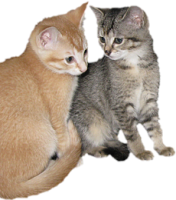 Roundworms, Toxocara cati and Toxascaris leonine, are common in young cats and kittens. Cats are infested with roundworm by ingesting worm eggs passed in cat faeces or by eating animals such as mice, which are infested with roundworm.
Roundworms, Toxocara cati and Toxascaris leonine, are common in young cats and kittens. Cats are infested with roundworm by ingesting worm eggs passed in cat faeces or by eating animals such as mice, which are infested with roundworm.
Most kittens are infested with Toxocara cati through their mother’s milk.
Toxocara cati can infest children if they ingest eggs attached to kitten hair or dirty litter trains. The eggs hatch to larvae which migrate through the body and may cause damage. To prevent ingestion deworm kittens and cats as advised below, and dispose of litter and disinfect the tray with boiling water at least weekly.
Good quality broad spectrum wormers like Milbemax, Profender spot on and Drontal for cats are effective against all gastrointestinal worms.
Our recommended deworming protocol:
(This post is archived on our website at https://www.hallvet.com.au/about/pet-insurance/)
According to the Australian Companion Animal Council,
 But there are times when vet bills loom large because of accident or illness. In the last four years at Hall Veterinary Surgery, about 90% of invoices over $1000 were for dogs. They included conditions as diverse as dog-fight injuries, pancreatitis, surgery for cancers, blocked waterworks, broken bones or cruciate ligaments, snake bite, heart failure, car accidents, tick paralysis, vomiting, diarrhoea, and chemotherapy for cancer.
But there are times when vet bills loom large because of accident or illness. In the last four years at Hall Veterinary Surgery, about 90% of invoices over $1000 were for dogs. They included conditions as diverse as dog-fight injuries, pancreatitis, surgery for cancers, blocked waterworks, broken bones or cruciate ligaments, snake bite, heart failure, car accidents, tick paralysis, vomiting, diarrhoea, and chemotherapy for cancer.
Big bills hit young pets as well as old.
If unexpected vet bills would blow your budget, you could try one of these strategies to minimise the fallout:
The table below shows amounts carers spent on individual pets over the last four years. It breaks this down to the average monthly cost of vet care and the percentage of dogs and cats in that spend category. This is the average per pet for all products and services offered at Hall Vet Surgery, including flea and tick products, prescription diets, dental work, big surgeries, cancer treatment, desexing and vaccinations.
| Total spent over 4 Years | Ave per Month | Dogs | Cats |
| $500 | $10 | 54% | 38% |
| $1,000 | $21 | 28% | 17% |
| $2,000 | $43 | 9% | 4% |
| $5,000 | $104 | 1% | 0.4% |
| $10,000 | $208 | 0.1% |
So you can think of the percentages as indicative of the chance that your pet will cost at least that much in vet bills. eg if you own a cat, there’s a 1:250 chance your cat might total $5,000, or a 1:10 chance that your dog might cost over $2,000 over four years.
Pet insurance is more cost-effective if your pet is unlucky enough to have a bad accident or becomes ill. But you have to have your pet insured before it happens!
Hookworms attach to the intestinal wall with hook-like mouthparts. They are hard to see because they are only about 3 mm long and very thin.
Dogs are infested with hookworms in one of three ways:
1. Hookworm larvae pass from the dam to the pups through the placenta before birth
2. Pups ingest larvae in the mother’s milk
3. Larvae penetrate the skin
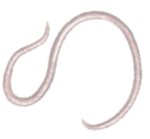 What problems do hookworms cause?
What problems do hookworms cause?
Hookworms suck blood from the tiny vessels in the intestinal wall and cause anaemia especially in puppies. Pale gums, lethargy and weakness are signs of anaemia.
Hookworm also cause bloody diarrhoea, weight loss and failure to grow.
Hookworm larvae burrow into the skin and cause itching and discomfort in a heavily infested environment such as kennels.
How do we diagnose hookworm infestation?
Hookworms produce a lot of eggs which are easily found in faeces under a microscope. Faecal examination is less reliable in very young puppies.
How is hookworm treated?
Most broad spectrum wormers, like Milbemax and Drontal, kill adult hookworms. We repeat the treatment 2-4 weeks later to kill the next wave of larvae maturing into adult worms.
Are canine hookworms infectious to people?
Adult hookworms do not infect humans. However, hookworm larvae can burrow into human skin and cause itching. They do not mature into adults. Wear shoes to avoid skin contact with hookworm infested soil especially in wet weather.
How do we prevent hookworm infection?
1. Deworm pups at six weeks of age
2. Deworm pets at high risk of reinfestation
3. Pick up and dispose of dog faeces, especially in yards, playgrounds, and public parks.
4. Do not allow children to play in potentially contaminated environments.
5. Treat nursing bitches concurrently with their pups.
6. Use broad spectrum worm treatments that are effective against hookworms.
Roundworms, also known as ascarids, have round bodies and are 7-12 cm long. They live in dogs’ intestines on partially digested food.
Pups infested with roundworms lose weight and look pot-bellied. They lose their appetites and may vomit or develop diarrhoea. Serious roundworm infestations obstruct or twist the bowel.
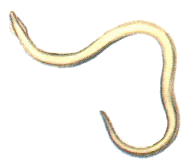 Most puppies acquire roundworm infection from their mothers before birth and then through the milk afterward.
Most puppies acquire roundworm infection from their mothers before birth and then through the milk afterward.
Both puppies and adult dogs are also infected by swallowing roundworm eggs from bowls, hair or dirt contaminated with faeces. They can also be infected by roundworm larvae encysted in the organs of prey like mice, cockroaches, earthworms and chickens.
Ingested larvae and eggs are activated in the dog’s stomach and small intestine and migrate through the muscle, liver, and lungs. After several weeks, the larvae make their way back to the intestine to mature. When these worms begin to reproduce, new eggs will pass in the dog’s faeces, and the life cycle of the parasite is completed.
Roundworm eggs in the faeces confirm roundworm infestation. Because roundworm don’t produce many eggs we sometimes have to examine several fecal samples before we find eggs. Occasionally, we see mature worms in the dog’s vomit or faeces.
Treatment with broad-spectrum wormers like Milbemax or Drontal eliminates adult roundworm. No treatment reliably kills the migrating larvae so we give two or three treatments 2 weeks apart catch them as they mature into adult worms.
The eggs are resistant to most disinfectants and survive in quite harsh environmental conditions. They remain infective to dogs and humans for years.
Regular removal of dog faeces and deworming as detailed below prevent reinfection.
Roundworms are a risk to human health. Children and people who are immunosuppressed or on immunosuppressive drugs are particularly vulnerable. The roundworm eggs only develop as far as larvae in people. As the larvae migrate through the body they can cause damage, particularly to the eye. Worming people does not kill the larvae as only adult worms are susceptible to wormers. To prevention human infestation
Whipworms live in the large intestine of dogs and irritate the lining causing watery, bloody diarrhoea and weight loss.
Whipworms produce microscopic eggs that pass out in the dog’s faeces. The eggs resist drying and heat, and can infect another dog years later. Dogs housed on dirt or grass that is not regularly cleaned of faeces risk whipworm infestation.
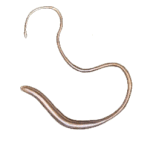 Whipworm eggs in the faeces confirm a whipworm infestation. However, they are often hard to find as the worms only produce small numbers of eggs on an irregular basis. Any dog with chronic diarrhoea could have whipworms despite negative faecal examinations. Response to treatment indicates that whipworms were present after all.
Whipworm eggs in the faeces confirm a whipworm infestation. However, they are often hard to find as the worms only produce small numbers of eggs on an irregular basis. Any dog with chronic diarrhoea could have whipworms despite negative faecal examinations. Response to treatment indicates that whipworms were present after all.
Most broad spectrum wormers, including Milbemax and Drontal are effective against whipworms.
Whipworms are not infectious to people. They are only parasites of the dog.
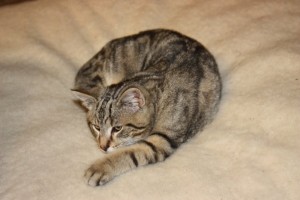 Feline leukaemia virus (FeLV) is an important viral infection of young cats in multi-cat households. Over the last few years infection has become less common.
Feline leukaemia virus (FeLV) is an important viral infection of young cats in multi-cat households. Over the last few years infection has become less common.
What diseases are associated with FeLV?
FeLV infection suppresses the immune system making the cat susceptible to secondary infections and chronic diseases that would not affect a normal healthy cat. These include mouth ulceration, cat flu, and fungal infections.
Cancers of the white blood cells and solid tumours such as lymphoma cause 10-25% of FeLV deaths.
Anaemia and other blood cell abnormalities are very common in FeLV infected cats. Other FeLV-related diseases include abortion, fading kittens, diarrhoea, neurological or nervous system signs, and immune-mediated disease.
Around 80-90% of persistently FeLV-infected cats will die within 3.5 years of diagnosis.
How is the virus transmitted?
The virus is transmitted by direct contact between cats during grooming or sharing of litter trays and food bowls over a long period of time.
The virus is fragile and does not survive for long in the environment.
An infected queen passes the virus on to all her kittens if she carries them to term. However, this is uncommon as infection with FeLV usually causes infertility or abortion.
What happens when a cat is exposed to FeLV?
Not all cats exposed to FeLV go on to develop FeLV-related diseases. Most cats eliminate the virus from the body, although some remain latently infected for a few months before they conquer the virus completely.
In cat colonies where the virus is endemic only 30% of cats are persistently infected with FeLV and go on to develop FeLV-related disease. These cats are responsible for the transmission of FeLV to other cats.
How do we diagnose FeLV?
A test at the surgery detects FeLV virus in the blood of a persistently infected cat.
A negative result is always negative. Your vet will assess the predictive value of a positive result by taking your cat’s environment, housemates and outside access into account.
Cats in the process of eliminating the virus will test positive. A second test performed 8-12 weeks after the first test confirms persistent infection.
Is there any treatment for FeLV infection?
There is no treatment that eliminates the virus from the body.
Infected cats should be desexed and confined indoors to prevent exposure to infectious agents and other cats.
Because FeLV-infected cats are more susceptible to disease, vaccination for the common viruses that cause cat flu and enteritis is very important.
We treat secondary infections and other problems like mouth ulcers as they arise.
Most FeLV-infected cats eventually die of their infection or we elect to euthanase them if they are suffering.
Can we prevent infection?
If possible do not house your cat with a known infected cat. Any new cat to the household should test negative for FeLV.
If all the cats in the house are FeLV negative, confinement indoors will prevent casual exposure to wandering cats with the virus.
Breeders may prevent FeLV infection by blood testing all cats and isolating infected individuals.
Vaccination of cats in contact with other infected or potentially infected cats is advisable. As with other vaccines, an initial course of two injections is required, and annual boosters are necessary to maintain immunity.